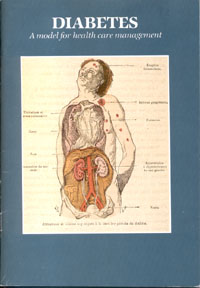Sign up to our newsletter Subscribe
Analysing Global Immunisation Expenditure

Since the Office of Health Economics first published a paper about diabetes 25 years ago a great deal has happened.
For one thing diabetes mellitus has been accepted as an international problem by the World Health Organisation. Professor Hoet, father of the present…
Since the Office of Health Economics first published a paper about diabetes 25 years ago a great deal has happened.
For one thing diabetes mellitus has been accepted as an international problem by the World Health Organisation. Professor Hoet, father of the present Professor of Medicine at Brussels University and currently the President of the International Diabetes Federation, played a major role in achieving this in the 1960s. Until then the Geneva Head Office had put the condition aside as a disease of affluence, of no particular concern to an Agency like WHO primarily concerned with helping developing nations. I know it seemed then to some WHO staff a dubious investment of their resources, but as things have turned out. the decision is now paying handsome health dividends.
By taking the initiative of the 1960s, WHO proposed levels of blood glucose for the diagnosis of diabetes and how to measure them. This was an essential step forward. It tidied up an unsatisfactory ethical state of affairs: countries with predominently private practice medicine were interested in setting low criteria to raise the number of cases for the physicians’ offices appointment books. By contrast, health administrators generally wanted a diagnostic level above which expensive complications would usually be an added burden on health services. International administrators and those interested in the anthropology of diabetes needed agreed diagnostic levels to ensure comparability of the many epidemiological studies emerging everywhere. As it has turned out, all this has given insight into the ways diabetes affects unsophisticated populations when they are exposed to modern life-styles. As the New Zealander, Ian Prior said, in the Pacific Isles an outboard motorboat engine may precipitate diabetes in a Polynesian fisherman used to paddling and sailing his boat.
So the excellent paper published here by William Laing and Rhys Williams, looks at diabetes worldwide, not just in Britain as its predecessor did. The section on epidemiology in different countries is bound to interest readers in all parts of the world. So will the authors’ careful studies of the prevelances of various diabetic complications, in various circumstances and in various countries. In older patients these complications are often the first symptoms of the disease, bringing the patient to the doctor.
Interest in the molecular biology of diabetic complications, including the accumulation of sorbitol in some cells in diabetics, has also grown in the last quarter of a century. Since Max Perutz patiently unravelled the complex structure of haemoglobin molecules, it has become apparent that during their exposure in red cells to ambient glucose levels for over one hundred days, certain constituent amino-acids take up glucose and the haemoglobin becomes glycosylated. This changes the physical characteristics – the electrophoretic migration, which makes it possible to determine the percentage prevalence – up to 8.5 per cent or so in normal people. Exposure to high glucose concentrations results not only in a rise in this percentage, but there have also been reports of a reduction in the efficiency of the glycosylated haemoglobin molecule unfolding to accept and deliver oxygen molecules to the tissues.
Similar glycosylation almost certainly occurs in other structurally important proteins with a slow body turnover and may change their biophysical functions too. Glycosylation may lie behind lens changes in the eye and probably in the changes in the capillary basement membranes. Naturally, over the last quarter of a century, these ideas have reinforced the epidemiological and community studies which laid increasing emphasis on the need to control diabetics’ glucose levels. This puts extra work on physicians and their support workers. If they are going to control the complications and avoid serious impact on patients health through diseases in the heart, stroke, the peripheral vessels, the kidneys, the retinal capillaries as well as the optic lenses, the peripheral nerves, the skin and so on, diabetologists need to know personal glucose levels at home. This has become possible with new, though expensive, devices. So the way ahead seems clear if demanding.
The overall burden of diabetes on health care services has been increased, and further aggravated by rising prevelances of obesity and therefore of non-insulin dependent diabetics – as well as by longer lives, especially in the emerging nations. All this means that WHO’s very proper primary concern with preventive medicine can move from the successes of vaccination to the long drawn out, intractable problems of the control of diabetes. Painstaking medical care, based on careful personal education of each diabetic case and proper therapy, can and will make major medical and economic contributions to human wellbeing worldwide.
Laing, W. and Williams, R.
(1989) Diabetes: a Model for Health Care Management. OHE Series on Health. Available from https://www.ohe.org/publications/diabetes-model-health-care-management/